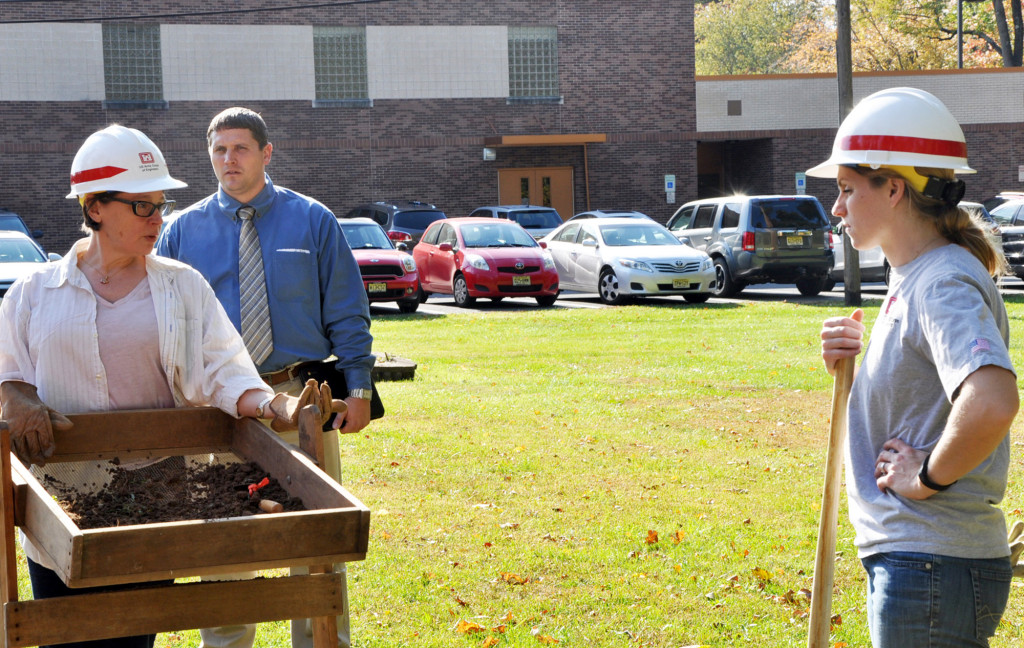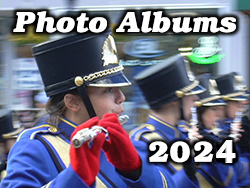Sometimes learning opportunities present themselves unexpectedly. Thanks to Lynn Rakos, an archaeologist with the U.S. Army Corps of Engineers, New York District, students at Green Brook Middle School had that opportunity. Recently, Ms. Rakos and colleague Carissa Scarpa were scheduled to perform an archaeological survey on the grounds of Green Brook Middle School in Green Brook, NJ. They were to examine soil for artifacts to test for archaeological resources prior to construction of an access road. The road is part of the Army Corps of Engineers’ expansive Green Brook Flood-Control Project which is designed to reduce flood risk from the Raritan River and Green Brook that has plagued the area for decades.
Prior to the dig, Ms. Rakos, realizing a learning opportunity, contacted the school offering to speak with students about the work and that of the Army Corps of Engineers. The school agreed and arrangements were made for two classes to visit the site: one in the morning and another in the afternoon. On a bright October morning, students arrived as Ms. Rakos and Ms. Scarpa were excavating soil. Speaking to social studies students from Brian Mojta’s, Dana Sweeney’s, and Kevin Weeks’ classes, artifacts common to Native American and local historic sites were displayed. Students were asked to identify the artifacts and point out the most recent (newest) artifact — a lens from a pair of sunglasses. Handouts of historical maps from the Revolutionary War era through the mid-20th century were distributed on which the school’s location was identified, so students could see what had been in the vicinity of their school through time.
Students were also quizzed on the meaning of archaeology. One student responded: “Things left behind by people who lived in the past,” which is close to the technical definition: The study of past cultures through materials (physical remains) that people left behind. The class witnessed first-hand the process of testing sites. Several students recorded and videotaped Ms. Rakos and Ms. Scarpa answering a series of questions as part of a National History Day competition, a nationwide initiative motivating children to study the past. Some questions were: How has archaeology helped the progression of science? In your opinion, how will archaeologists of the future view this time period and our impact on the environment?
In the afternoon, fifth graders descended on the area for a similar lesson. They witnessed soil sifted through a screen to look for artifacts. A plastic sheet below the screen was used to collect the soil to help refill holes and limit disturbance to the school grounds. After each test, findings were recorded on a survey sheet — types of soil(s), depths, artifacts collected, etc. Standard equipment used at the site included: a shovel, trowel, measuring tape, drawing equipment, and a screen to sift soils. On this day, no significant artifacts were found, just pieces of glass and ceramic tile — nothing impacting planned construction.
Archaeological work in the Army Corps of Engineers’ New York District is not restricted to land. Ms. Rakos and Ms. Scarpa oversee remote sensing and dive surveys of New York Harbor and offshore areas searching for shipwrecks and artifacts prior to dredging. Ms. Rakos said what she enjoys most about archaeology is field work, noting, “It’s great to be outside, and when you dig you never know what you will find,” adding, “I also like to read the landscape to determine what the soils might hold.” When asked about challenges, she spoke about piecing together evidence from the field with documentary research to tell the story of the site.
- Home
- Publications
- Berkeley Heights Community News
- Clark Monthly
- The Chathams
- Cranford Monthly
- Elmora Hills
- Fanwood Post
- Florham Park Press
- Garwood Times
- Green Brook Gazette
- Kenilworth Business Life
- Life in Linden
- Long Hill Leader
- Madison Monthly
- Millburn Short Hills Monthly
- Mountainside View
- New Providence News
- Our Town Rahway
- Peterstown NJ
- Roselle Park Monthly
- Scotch Plains Monthly
- Spirit of Union
- Summit Times
- The Pride of North Plainfield
- Warren Monthly
- Watchung Post
- Westfield Monthly
- Articles
- NJLocalinfo
- Advertising Information
- About
- Submit News
- Photos






